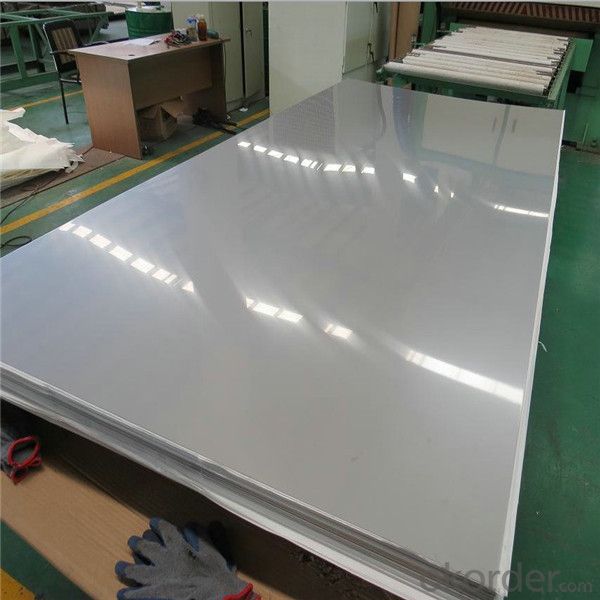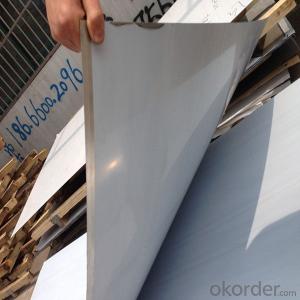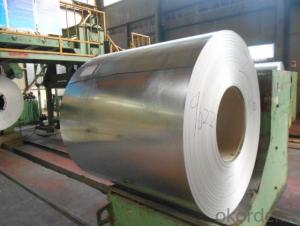304 Stainless Steel Sheet Widely Use Plate
- Loading Port:
- Shanghai
- Payment Terms:
- TT OR LC
- Min Order Qty:
- 2 m.t.
- Supply Capability:
- 20000 m.t./month
OKorder Service Pledge
OKorder Financial Service
You Might Also Like
Item specifice
304 stainless steel sheet Widely Use Plate
We are a professional manufacturer of stainless steel sheet. According to ASTM, JIS and AISI,GB, standards, Jaway steel enhances effectiveness and of quality control from selecting the raw materials, cutting, slitting, shearing, surface treatment, packing, exporting of the existing products.
Widely Use Plate 430 Stainless Steel Price with 1.2mm thick 1250mm width
Goods | 304 stainless steel sheet |
Specification | Width: 1000mm-1500mm or as required Length :1000mm-6000mm or as required |
Surface | 2B NO.1 BA Hairline 4K 6K 8K No.3 No.4 |
Type | Sheet/Plate |
Thickness | 0.5 mm-20mm |
Brand | TISCO JISCO LISCO and so on |
Application | stainless steel plate applies to construction field, ships building industry, petroleum & chemical industries, war and electricity industries, food processing and medical industry, boiler heat exchanger, machinery and hardware fields |
Parking | interlayer paper kraft paper wooden packing or as your requirement |
Finishings
| Surface | Definition | Application |
| NO.1 | The surface finished by heat treatment and pickling or processes corresponding there to after hot rolling. | Chemical tank, pipe. |
| 2B | Those finished, after cold rolling, by heat treatment, pickling or otherequivalent treatment and lastly by cold rolling to given appropriateluster. | Medical equipment, Food industry, Construction material, Kitchen utensils. |
NO.3 | Those finished by polishing with No.100 to No.120 abrasives specified in JIS R6001. | Kitchen utensils, Building construction |
NO.4 | Those finished by polishing with No.150 to No.180 abrasives specified in JIS R6001. | Kitchen utensils, Building construction, Medical equipment. |
HL | Those finished polishing so as to give continuous polishing streaks byusing abrasive of suitable grain size | Building Construction. |
BA (No.6) | Those processed with bright heat treatment after cold rolling.
| Kitchen utensils, Electric equipment, Building construction. |
Mirror (No.8) | Shinning like a mirror | Building construction |
These are the normal items, for the special requirements,we can also meet.
Surface finish | Characteristics and application |
NO.2B | The surface brightness and flatness of no2B is better than no2D. then through a special surface treatment to improve its mechanical properties,No2B could nearly satisfy comprehensive uses. |
NO.3 | Polished with abrasive belt of git#100-#200, have better brightness with discontinuous coarse stria, used as inner and external ornaments for building, electrical appliances and kitchen utensils etc. |
NO.4 | Polished with abrasive belt of grit #150-#180,have better brightness with discontinuous coarse stria,but thinner than No3, are used as bathtub buildings inner and external ornaments electrical appliances kitchen utensils and food processing equipment etc. |
HL | Polished with abrasive belt of grit #150-#320 on the NO.4 finish and has continuous streaks, mainly used as buildings ornaments elevators,door of building, frontal plate etc. |
BA | Cold rolled, bright annealed and skin-passed, the product have excellent brightness and good reflexivity like mirror,kitchen apparatus,ornament etc. |
8K | The product have excellent brightness and prefer reflexivity can to be the mirror. |


Our Advantages
• All products are made of high-quality imported raw materials.
• Our products are certified by ISO9001:2008 authentication quality systems.
• we are nominated as the AAA enterprise by Jiangsu government.
• Quick Response to Your Enquiry.
- Q:Are stainless steel sheets suitable for food processing?
- Indeed, stainless steel sheets prove to be an excellent choice for food processing purposes. The food and beverage industry extensively utilizes stainless steel owing to its exceptional properties and hygienic characteristics. Notably, it does not react with food, is highly resistant to corrosion, and does not introduce any taste or smell to the processed food. Moreover, stainless steel is effortless to clean and upkeep, rendering it an optimal selection for food processing machinery, worktops, and various other surfaces. Additionally, it withstands elevated temperatures and effectively resists bacterial proliferation, thereby establishing itself as a reliable and secure material for food processing activities.
- Q:Are stainless steel sheets resistant to caustic soda?
- Yes, stainless steel sheets are generally resistant to caustic soda. Caustic soda, also known as sodium hydroxide, is a highly corrosive substance, but stainless steel is known for its excellent corrosion resistance. Stainless steel contains chromium, which forms a protective oxide layer on the surface of the metal, preventing it from reacting with caustic soda. However, it is important to note that the exact resistance of stainless steel to caustic soda may vary depending on the grade or type of stainless steel. Therefore, it is always recommended to consult the specific material specifications or consult with a qualified professional to ensure the appropriate choice of stainless steel for specific applications involving caustic soda.
- Q:Can stainless steel sheets be used for medical instruments?
- Yes, stainless steel sheets can be used for medical instruments. Stainless steel is a common material choice in the medical industry due to its excellent corrosion resistance, durability, and ease of sterilization. It is widely used in various medical instruments such as surgical tools, implants, and equipment due to its hygienic properties and ability to withstand harsh cleaning and sterilization processes.
- Q:Can stainless steel sheets be used in marine environments?
- Yes, stainless steel sheets can be used in marine environments. Stainless steel is highly resistant to corrosion, making it suitable for marine applications where it will be exposed to saltwater and high humidity. It is commonly used in marine vessels, offshore platforms, and other structures that require durability and resistance to rust and corrosion.
- Q:How do you clean and maintain stainless steel sheets?
- To clean and maintain stainless steel sheets, you can start by wiping them down with a soft cloth or sponge dipped in warm, soapy water. Avoid using abrasive cleaners or scrub brushes that can scratch the surface. Rinse the sheets thoroughly and dry them with a clean cloth to prevent water spots. For regular maintenance, you can use a stainless steel cleaner or a mixture of equal parts water and vinegar to remove any fingerprints or smudges. Finally, remember to always wipe in the direction of the grain to maintain the steel's polished appearance.
- Q:What is the minimum thickness of stainless steel sheets available?
- The minimum thickness of stainless steel sheets offered may differ based on the manufacturer and the particular grade of stainless steel employed. Typically, the thinnest stainless steel sheets offered range from 0.4mm to 0.5mm. Nevertheless, it is worth mentioning that certain manufacturers might provide thinner sheets, like 0.3mm, although these may be more specialized or not as readily accessible. If you have a specific thickness requirement for your project, it is advisable to seek guidance from stainless steel suppliers or manufacturers to ascertain the available choices.
- Q:How do you remove rust from stainless steel sheets?
- To remove rust from stainless steel sheets, you can try using a mixture of baking soda and water to create a paste. Apply the paste to the affected area and gently scrub it with a non-abrasive cloth or sponge. Rinse thoroughly with water and dry the sheets completely. Additionally, you can use white vinegar or lemon juice by applying it directly to the rust spots and letting it sit for a few minutes before scrubbing and rinsing.
- Q:What are the different types of stainless steel alloys used for sheets?
- There are several different types of stainless steel alloys commonly used for sheets, such as austenitic stainless steel, ferritic stainless steel, martensitic stainless steel, and duplex stainless steel. Each alloy has its own unique properties and characteristics, making them suitable for various applications and environments.
- Q:Are stainless steel sheets suitable for chemical reactors?
- Chemical reactors can utilize stainless steel sheets as they possess favorable properties for this purpose. The chemical industry often opts for stainless steel due to its exceptional resistance to corrosion. It can withstand a broad spectrum of chemicals, including acids, alkalis, and solvents, without experiencing significant deterioration or reacting with the substances being processed. The selection of stainless steel sheets for chemical reactors is primarily based on their high strength, durability, and ability to withstand high temperatures and pressure. They can endure the challenging conditions and aggressive substances encountered in chemical processes, all while maintaining their structural integrity. Furthermore, stainless steel sheets are easy to clean and maintain, making them well-suited for applications where cleanliness is of utmost importance, such as the pharmaceutical and food processing industries. They also exhibit excellent heat transfer properties, enabling efficient temperature control within the reactor. In conclusion, stainless steel sheets are a dependable option for chemical reactors due to their corrosion resistance, strength, durability, and thermal properties. They offer a secure and long-lasting solution for handling various chemicals, making them widely utilized in the chemical industry.
- Q:How do I determine the flatness of stainless steel sheets?
- To assess the flatness of stainless steel sheets, the following steps can be followed: 1. Visual Examination: Initially, visually inspect the sheet for any visible indications of warping, bending, or unevenness. Look for noticeable waves, ripples, or twists on the surface. While this method may not provide precise results, it can give a preliminary understanding of the overall flatness of the sheet. 2. Straight Edge Measurement: Position a straight edge, such as a ruler or long level, on the surface of the stainless steel sheet. Move the straight edge across different areas of the sheet, paying attention to both the center and edges. Observe if there are any gaps or spaces between the straight edge and the sheet. A continuous contact between the straight edge and the sheet suggests a satisfactory level of flatness. 3. Feeler Gauge Utilization: Employ a feeler gauge, which is a precise measurement tool containing thin metal blades of varying thicknesses. This tool can be used to more accurately measure the gap between the straight edge and the stainless steel sheet. Slide the feeler gauge into any gaps between the sheet and the straight edge, noting the blade thickness that fits snugly. This will help determine the extent of any unevenness or bowing present. 4. Laser Measurement: For more accurate measurements, a laser measuring device can be employed. Position the laser device at one end of the sheet and measure the distance from the laser to the surface at different points along the length of the sheet. Repeat this process at the opposite end of the sheet. Comparing these measurements will provide an indication of any variations in flatness. 5. Professional Testing: In cases where the stainless steel sheets are intended for critical applications or when precise flatness is essential, consulting with a professional testing service is advisable. These experts can employ advanced techniques such as optical profilometry or coordinate measuring machines to accurately measure the flatness of the sheet. It is important to acknowledge that due to the inherent characteristics of stainless steel, minor deviations from perfect flatness may be acceptable within industry standards. The required level of flatness will depend on the specific application and the tolerance standards set by the manufacturer or customer.
1. Manufacturer Overview |
|
|---|---|
| Location | |
| Year Established | |
| Annual Output Value | |
| Main Markets | |
| Company Certifications | |
2. Manufacturer Certificates |
|
|---|---|
| a) Certification Name | |
| Range | |
| Reference | |
| Validity Period | |
3. Manufacturer Capability |
|
|---|---|
| a)Trade Capacity | |
| Nearest Port | |
| Export Percentage | |
| No.of Employees in Trade Department | |
| Language Spoken: | |
| b)Factory Information | |
| Factory Size: | |
| No. of Production Lines | |
| Contract Manufacturing | |
| Product Price Range | |
Send your message to us
304 Stainless Steel Sheet Widely Use Plate
- Loading Port:
- Shanghai
- Payment Terms:
- TT OR LC
- Min Order Qty:
- 2 m.t.
- Supply Capability:
- 20000 m.t./month
OKorder Service Pledge
OKorder Financial Service
Similar products
New products
Hot products
Related keywords






























